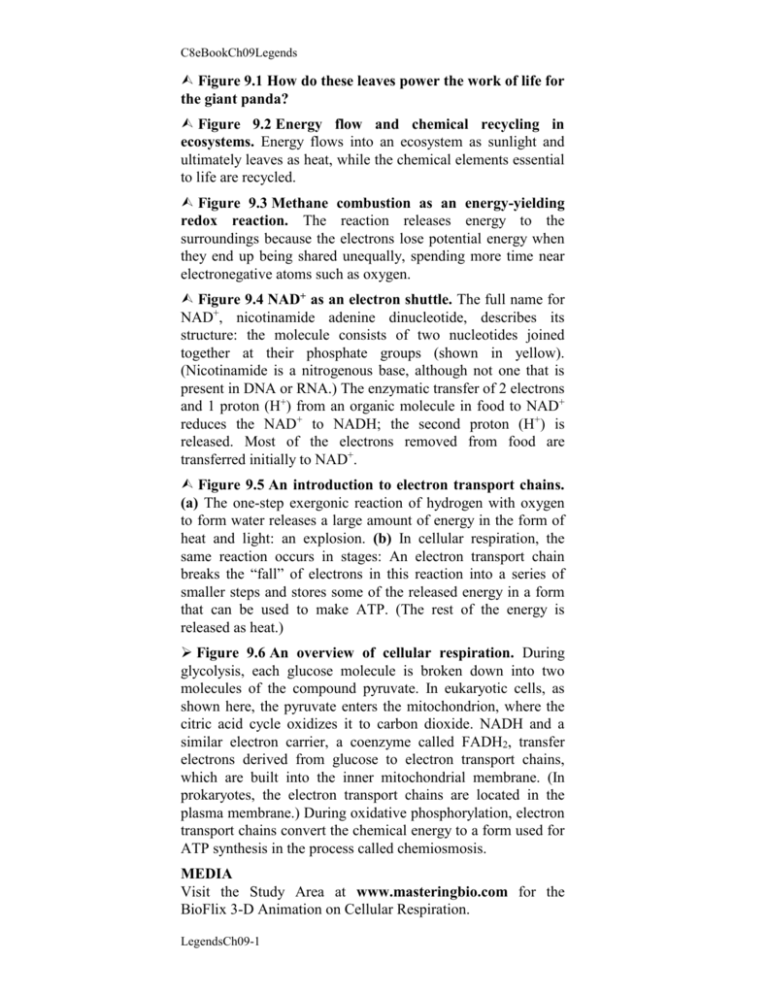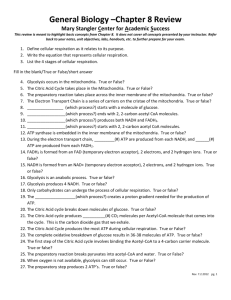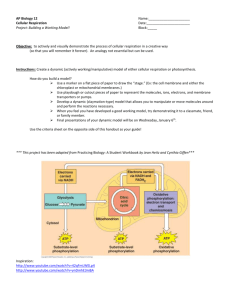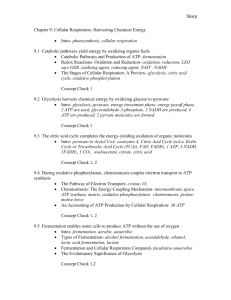CHAP NUM="9" ID="CH
advertisement

C8eBookCh09Legends Figure 9.1 How do these leaves power the work of life for the giant panda? Figure 9.2 Energy flow and chemical recycling in ecosystems. Energy flows into an ecosystem as sunlight and ultimately leaves as heat, while the chemical elements essential to life are recycled. Figure 9.3 Methane combustion as an energy-yielding redox reaction. The reaction releases energy to the surroundings because the electrons lose potential energy when they end up being shared unequally, spending more time near electronegative atoms such as oxygen. Figure 9.4 NAD+ as an electron shuttle. The full name for NAD+, nicotinamide adenine dinucleotide, describes its structure: the molecule consists of two nucleotides joined together at their phosphate groups (shown in yellow). (Nicotinamide is a nitrogenous base, although not one that is present in DNA or RNA.) The enzymatic transfer of 2 electrons and 1 proton (H+) from an organic molecule in food to NAD+ reduces the NAD+ to NADH; the second proton (H+) is released. Most of the electrons removed from food are transferred initially to NAD+. Figure 9.5 An introduction to electron transport chains. (a) The one-step exergonic reaction of hydrogen with oxygen to form water releases a large amount of energy in the form of heat and light: an explosion. (b) In cellular respiration, the same reaction occurs in stages: An electron transport chain breaks the “fall” of electrons in this reaction into a series of smaller steps and stores some of the released energy in a form that can be used to make ATP. (The rest of the energy is released as heat.) Figure 9.6 An overview of cellular respiration. During glycolysis, each glucose molecule is broken down into two molecules of the compound pyruvate. In eukaryotic cells, as shown here, the pyruvate enters the mitochondrion, where the citric acid cycle oxidizes it to carbon dioxide. NADH and a similar electron carrier, a coenzyme called FADH2, transfer electrons derived from glucose to electron transport chains, which are built into the inner mitochondrial membrane. (In prokaryotes, the electron transport chains are located in the plasma membrane.) During oxidative phosphorylation, electron transport chains convert the chemical energy to a form used for ATP synthesis in the process called chemiosmosis. MEDIA Visit the Study Area at www.masteringbio.com for the BioFlix 3-D Animation on Cellular Respiration. LegendsCh09-1 C8eBookCh09Legends Figure 9.7 Substrate-level phosphorylation. Some ATP is made by direct transfer of a phosphate group from an organic substrate to ADP by an enzyme. (For examples in glycolysis, see Figure 9.9, steps 7 and 10.) ? Do you think the potential energy is higher for the reactants or the products? Explain. Figure 9.8 The energy input and output of glycolysis. Figure 9.9 A closer look at glycolysis. The orientation diagram at the right relates glycolysis to the entire process of respiration. Do not let the chemical detail in the main diagram block your view of glycolysis as a source of ATP and NADH. WHAT IF? What would happen if you removed dihydroxyacetone phosphate as fast as it was produced? Figure 9.10 Conversion of pyruvate to acetyl CoA, the junction between glycolysis and the citric acid cycle. Pyruvate is a charged molecule, so in eukaryotic cells it must enter the mitochondrion via active transport, with the help of a transport protein. Next, a complex of several enzymes (the pyruvate dehydrogenase complex) catalyzes the three numbered steps, which are described in the text. The acetyl group of acetyl CoA will enter the citric acid cycle. The CO2 molecule will diffuse out of the cell. Figure 9.11 An overview of the citric acid cycle. To calculate the inputs and outputs on a per-glucose basis, multiply by 2, because each glucose molecule is split during glycolysis into two pyruvate molecules. Figure 9.12 A closer look at the citric acid cycle. In the chemical structures, red type traces the fate of the two carbon atoms that enter the cycle via acetyl CoA (step 1), and blue type indicates the two carbons that exit the cycle as CO2 in steps 3 and 4. (The red labeling goes only through step 5 because the succinate molecule is symmetrical; the two ends cannot be distinguished from each other.) Notice that the carbon atoms that enter the cycle from acetyl CoA do not leave the cycle in the same turn. They remain in the cycle, occupying a different location in the molecules on their next turn, after another acetyl group is added. As a consequence, the oxaloacetate that is regenerated at step 8 is composed of different carbon atoms each time around. In eukaryotic cells, all the citric acid cycle enzymes are located in the mitochondrial matrix except for the enzyme that catalyzes step 6, which resides in the inner mitochondrial membrane. Carboxylic acids are represented in their ionized forms, as —COO–, because the ionized forms prevail at the pH within the mitochondrion. For example, citrate is the ionized form of citric acid. LegendsCh09-2 C8eBookCh09Legends Figure 9.13 Free-energy change during electron transport. The overall energy drop (G) for electrons traveling from NADH to oxygen is 53 kcal/mol, but this “fall” is broken up into a series of smaller steps by the electron transport chain. (An oxygen atom is represented here as 1/2 O2 to emphasize that the electron transport chain reduces molecular oxygen, O2, not individual oxygen atoms.) Figure 9.14 ATP synthase, a molecular mill. The ATP synthase protein complex functions as a mill, powered by the flow of hydrogen ions. This complex resides in mitochondrial and chloroplast membranes of eukaryotes and in the plasma membranes of prokaryotes. Each of the four parts of ATP synthase consists of a number of polypeptide subunits. Figure 9.15 Inquiry Is the rotation of the internal rod in ATP synthase responsible for ATP synthesis? EXPERIMENT Previous experiments on ATP synthase had demonstrated that the “internal rod” rotated when ATP was hydrolyzed (see Figure 9.14). Hiroyasu Itoh and colleagues set out to investigate whether simply rotating the rod in the opposite direction would cause ATP synthesis to occur. They isolated the internal rod and catalytic knob, which was then anchored to a nickel plate. A magnetic bead was bound to the rod. This complex was placed in a chamber containing an array of electromagnets, and the bead was manipulated by the sequential activation of the magnets to rotate the internal rod in either direction. The investigators hypothesized that if the bead were rotated in the direction opposite to that observed during hydrolysis, ATP synthesis would occur. ATP levels were monitored by a “reporter enzyme” in the solution that emits a discrete amount of light (a photon) when it cleaves ATP. Their hypothesis was that rotation in one direction would result in more photons than rotation in the other direction or no rotation at all. [Insert art here.] RESULTS More photons were emitted by spinning the rod for 5 minutes in one direction (yellow bars) than by no rotation (gray bars) or rotation in the opposite direction (blue bars). [Insert art here.] CONCLUSION The researchers concluded that the mechanical rotation of the internal rod in a particular direction within ATP synthase appears to be all that is required for generating ATP. As ATP synthase is the smallest rotary motor known, one of the goals in this type of research is to learn how to use its activity in artificial ways. LegendsCh09-3 C8eBookCh09Legends SOURCE H. Itoh et al., Mechanically driven ATP synthesis by F1-ATPase, Nature 427:465–468 (2004). InquiryinAction Read and analyze the original paper in Inquiry in Action: Interpreting Scientific Papers. WHAT IF? The “no rotation” (gray) bars represent the background level of ATP in the experiment. When the enzyme is rotated one way (yellow bars), the increase in ATP level suggests synthesis is occurring. For enzymes rotating the other way (blue bars), what level of ATP would you expect compared to the gray bars? (Note: this may not be what is observed.) Figure 9.16 Chemiosmosis couples the electron transport chain to ATP synthesis. NADH and FADH2 shuttle highenergy electrons extracted from food during glycolysis and the citric acid cycle to an electron transport chain built into the inner mitochondrial membrane. The gold arrows trace the transport of electrons, which finally pass to oxygen at the “downhill” end of the chain, forming water. As Figure 9.13 showed, most of the electron carriers of the chain are grouped into four complexes. Two mobile carriers, ubiquinone (Q) and cytochrome c (Cyt c), move rapidly, ferrying electrons between the large complexes. As complexes I, III, and IV accept and then donate electrons, they pump protons from the mitochondrial matrix into the intermembrane space. (In prokaryotes, protons are pumped outside the plasma membrane.) Note that FADH2 deposits its electrons via complex II and so results in fewer protons being pumped into the intermembrane space than occurs with NADH. Chemical energy originally harvested from food is transformed into a proton-motive force, a gradient of H+ across the membrane. During chemiosmosis, the protons flow back down their gradient via ATP synthase, which is built into the membrane nearby. The ATP synthase harnesses the proton-motive force to phosphorylate ADP, forming ATP. Together, electron transport and chemiosmosis make up oxidative phosphorylation. WHAT IF? If complex IV were nonfunctional, could chemiosmosis produce any ATP, and if so, how would the rate of synthesis differ? Figure 9.17 ATP yield per molecule of glucose at each stage of cellular respiration. Figure 9.18 Fermentation. In the absence of oxygen, many cells use fermentation to produce ATP by substrate-level phosphorylation. Pyruvate, the end product of glycolysis, serves as an electron acceptor for oxidizing NADH back to NAD+, which can then be reused in glycolysis. Two of the LegendsCh09-4 C8eBookCh09Legends common end products formed from fermentation are (a) ethanol and (b) lactate, the ionized form of lactic acid. Figure 9.19 Pyruvate as a key juncture in catabolism. Glycolysis is common to fermentation and cellular respiration. The end product of glycolysis, pyruvate, represents a fork in the catabolic pathways of glucose oxidation. In a facultative anaerobe, which is capable of both aerobic cellular respiration and fermentation, pyruvate is committed to one of those two pathways, usually depending on whether or not oxygen is present. Figure 9.20 The catabolism of various molecules from food. Carbohydrates, fats, and proteins can all be used as fuel for cellular respiration. Monomers of these molecules enter glycolysis or the citric acid cycle at various points. Glycolysis and the citric acid cycle are catabolic funnels through which electrons from all kinds of organic molecules flow on their exergonic fall to oxygen. Figure 9.21 The control of cellular respiration. Allosteric enzymes at certain points in the respiratory pathway respond to inhibitors and activators that help set the pace of glycolysis and the citric acid cycle. Phosphofructokinase, which catalyzes an early step in glycolysis (see Figure 9.9), is one such enzyme. It is stimulated by AMP (derived from ADP) but is inhibited by ATP and by citrate. This feedback regulation adjusts the rate of respiration as the cell’s catabolic and anabolic demands change. LegendsCh09-5







